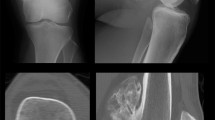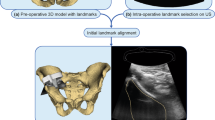Abstract
Introduction
Computerized surgical navigation system guidance can improve bone tumor surgical resection accuracy. This study compared the 10-mm planned resection margin agreement between simulated pelvic-region bone tumors (SPBT) resected using either skin fiducial markers or Kirschner (K)-wires inserted directly into osseous landmarks with navigational system registration under direct observation. We hypothesized that skin fiducial markers would display similar resection margin accuracy.
Methods
Six cadaveric pelvises had one SPBT implanted into each supra-acetabular region. At the left hemi-pelvis, the skin fiducial marker group had guidance from markers placed over the pubic tubercle, the anterior superior iliac spine, the central and more posterior iliac crest, and the greater trochanter (5 markers). At the right hemi-pelvis, the K-wire group had guidance from 1.4-mm-diameter wires inserted into the pubic tubercle, and 3 inserted along the iliac crest (4 K-wires). The senior author, a fellowship-trained surgeon performed “en bloc” SPBT resections. The primary investigator, blinded to group assignment, measured actual resection margins.
Results
Twenty of 22 resection margins (91%) in the skin fiducial marker group were within the Bland–Altman plot 95% confidence interval for actual–planned margin mean difference (mean = −0.23 mm; 95% confidence intervals = 2.8 mm, − 3.3 mm). Twenty-one of 22 resection margins (95%) in the K-wire group were within the 95% confidence interval of actual–planned margin mean difference (mean = 0.26 mm; 95% confidence intervals = 1.7 mm, − 1.1 mm).
Conclusion
Pelvic bone tumor resection with navigational guidance from skin fiducial markers placed over osseous landmarks provided similar accuracy to K-wires inserted into osseous landmarks. Further in vitro studies with different SPBT dimensions/locations and clinical studies will better delineate use efficacy.




Similar content being viewed by others
References
Anon (2022) Key statistics about bone cancer. Bone Cancer Statistics. https://www.cancer.org/cancer/bone-cancer/about/key-statistics.html. Accessed 31 Dec 2023
Bacci G, Longhi A, Versari M et al (2006) Prognostic factors for osteosarcoma of the extremity treated with neoadjuvant chemotherapy: 15-year experience in 789 patients treated at a single institution. Cancer 106(5):1154–1161. https://doi.org/10.1002/cncr.21724
Bertrand TE, Cruz A, Binitie O et al (2016) Do surgical margins affect local recurrence and survival in extremity, nonmetastatic, high-grade osteosarcoma? Clin Orthop Relat Res 474(3):677–683. https://doi.org/10.1007/s11999-015-4359-x
Woerdeman PA, Willems PW, Noordmans HJ, Tulleken CA, van der Sprenkel JW (2007) Application accuracy in frameless image-guided neurosurgery: a comparison study of three patient-to-image registration methods. J Neurosurg 106(6):1012–1016. https://doi.org/10.3171/jns.2007.106.6.1012
Woerdeman PA, Willems PW, Noordmans HJ, van der Berkelbach Sprenkel JW (2007) The effect of repetitive manual fiducial localization on target localization in image space. Operative Neurosurgery 60(2 Suppl 1):100–104. https://doi.org/10.1227/01.NEU.0000249231.74741.C3. (Discussion ON S103–4)
Zamora R, Punt SE, Christman-Skieller C et al (2019) Are skin fiducials comparable to bone fiducials for registration when planning navigation-assisted musculoskeletal tumor resections in a cadaveric simulated tumor model? Clin Orthop Relat Res 477(12):2692–2701. https://doi.org/10.1097/CORR.0000000000000924
Anderson KC, Buehler KC, Markel DC (2005) Computer assisted navigation in total knee arthroplasty: comparison with conventional methods. J Arthroplasty 20(7 suppl 3):132–138. https://doi.org/10.1016/j.arth.2005.05.009
Gebhard F, Weidner A, Liener UC et al (2004) Navigation at the spine. Injury 35(Suppl 1):A35–A45. https://doi.org/10.1016/j.injury.2004.05.009
Jaramaz B, DiGioia AM, Blackwell M et al (1998) Computer assisted measurement of cup placement in total hip replacement. Clin Orthop Relat Res 354:70–81. https://doi.org/10.1097/00003086-199809000-00010
Kosugi Y, Watanabe E, Goto J et al (1988) An articulated neurosurgical navigation system using MRI and CT images. IEEE Trans Biomed Eng 35(2):147–152. https://doi.org/10.1109/10.1353
van der List JP, Chawla H, Joskowicz L et al (2016) Current state of computer navigation and robotics in unicompartmental and total knee arthroplasty: a systematic review with meta-analysis. Knee Surg Sports Traumatol Arthrosc 24(11):3482–3495. https://doi.org/10.1007/s00167-016-4305-9
Sefcik RK, Rasouli J, Bederson JB et al (2017) Three-dimensional, computer simulated navigation in endoscopic neurosurgery. Interdiscip Neurosurg Adv Tech Case Manag 8:17–22. https://doi.org/10.1016/j.inat.2017.01.003
Wixson RL, MacDonald MA (2005) Total hip arthroplasty through a minimal posterior approach using imageless computer-assisted hip navigation. J Arthroplasty 20(7 suppl 3):51–56. https://doi.org/10.1016/j.arth.2005.04.024
Ieguchi M, Hoshi M, Takada J et al (2012) Navigation-assisted surgery for bone and soft tissue tumors with bony extension. Clin Orthop Relat Res 470(1):275–283. https://doi.org/10.1007/s11999-011-2094-5
Zamora R (2016) Preliminary validation of skin fiducials for navigation-assisted musculoskeletal tumor resections: a cadaver study. In: Connective Tissue Oncology Society annual meeting program: Nov 9–12; Connective Tissue Oncology Society, Lisbon, Portugal, Alexandria, p 80
Abraham JA, Kenneally B, Amer K et al (2018) Can navigation-assisted surgery help achieve negative margins in resection of pelvic and sacral tumors? Clin Orthop Relat Res 476(3):499–508. https://doi.org/10.1007/s11999.0000000000000064
Cartiaux O, Docquier P-L, Paul L et al (2008) Surgical inaccuracy of tumor resection and reconstruction within the pelvis: an experimental study. Acta Orthop 79(5):695–702. https://doi.org/10.1080/17453670810016731
Hüfner T, Kfuri M, Galanski M et al (2004) New indications for computer-assisted surgery: tumor resection in the pelvis. Clin Orthop Relat Res 426:219–225. https://doi.org/10.1097/01.blo.0000138958.11939.94
Krettek C, Geerling J, Bastian L et al (2004) Computer aided tumor resection in the pelvis. Injury 35(Suppl 1):A79-83. https://doi.org/10.1016/j.injury.2004.05.014
Jeys L, May PL (2016) Bone tumor navigation in the pelvis. In: Ritacco LE, Milano FE, Chao E (eds) Computer-assisted musculoskeletal surgery: thinking and executing in 3D. Springer, Cham, pp 71–87
Eccles C, Whitaker J, Nyland J et al (2018) Skin fiducial markers enable accurate computerized navigation resection of simulated soft tissue tumors: a static cadaveric model pilot study. J Surg Oncol 118(3):510–517. https://doi.org/10.1002/jso.25155
Anderson SD (2006) Practical light embalming technique for use in the surgical fresh tissue dissection laboratory. Clin Anat 19(1):8–11. https://doi.org/10.1002/ca.20216
Conrad EU III, Ng V, Weisstein J, Lisle J, Sternheim A, Malawer MM (2016) In: Mallawer MM, Wittig JC, Bickels J, Wiesel SW (eds) Operative techniques in orthopaedic surgical oncology, 2nd edn. Wolters Kluwer, Philadelphia, pp 197–216
Chhapola V, Kanwal SK, Brar R (2015) Reporting standards for Bland–Altman agreement analysis in laboratory research: a cross-sectional survey of current practice. Ann Clin Biochem 52(pt 3):382–386. https://doi.org/10.1177/0004563214553438
Giavarina D (2015) Understanding Bland–Altman analysis. Biochemia Med 25(2):141–151. https://doi.org/10.11613/BM.2015.015
Biazzo A, De Paolis M (2016) Multidisciplinary approach to osteosarcoma. Acta Orthop Belg 82(4):690–698
He F, Zhang W, Shen Y et al (2016) Effects of resection margins on local recurrence of osteosarcoma in extremity and pelvis: systematic review and meta-analysis. Int J Surg Lond Engl 36(pt A):283–292. https://doi.org/10.1016/j.ijsu.2016.11.016
Whelan JS, Davis LE (2018) Osteosarcoma, chondrosarcoma, and chordoma. J Clin Oncol 36(2):188–193. https://doi.org/10.1200/JCO.2017.75.1743
Guder WK, Hardes J, Nottrott M et al (2020) Pelvic Ewing sarcoma: a retrospective outcome analysis of 104 patients who underwent pelvic tumor resection at a single supra-regional center. J Orthop Surg 15(1):534. https://doi.org/10.1186/s13018-020-02028-3
Guo W, Sun X, Ji T et al (2012) Outcome of surgical treatment of pelvic osteosarcoma. J Surg Oncol 106(4):406–410. https://doi.org/10.5704/MOJ.1303.018
Guo Z, Li J, Pei G-X et al (2010) Pelvic reconstruction with a combined hemipelvic prostheses after resection of primary malignant tumor. Surg Oncol 19(2):95–105. https://doi.org/10.1016/j.suronc.2009.04.003
Parry MC, Laitinen M, Albergo J et al (2016) Osteosarcoma of the pelvis. Bone Joint J 98-B(4):555–563. https://doi.org/10.1302/0301-620X.98B4.36583
Cartiaux O, Banse X, Paul L et al (2013) Computer-assisted planning and navigation improves cutting accuracy during simulated bone tumor surgery of the pelvis. Comput Aided Surg 18(1–2):19–26. https://doi.org/10.3109/10929088.2012.744096
Wong K-C, Kumta S-M (2014) Use of computer navigation in orthopedic oncology. Curr Surg Rep 2(4):47. https://doi.org/10.1007/s40137-014-0047-0
Young PS, Bell SW, Mahendra A (2015) The evolving role of computer-assisted navigation in musculoskeletal oncology. Bone Joint J 97-B(2):258–264. https://doi.org/10.1302/0301-620X.97B2.34461
Fujiwara T, Kunisada T, Takeda K et al (2018) Intraoperative O-arm-navigated resection in musculoskeletal tumors. J Orthop Sci 23(6):1045–1050. https://doi.org/10.1016/j.jos.2018.06.012
Ritacco LE, Milano FE, Farfalli GL et al (2013) Accuracy of 3-D planning and navigation in bone tumor resection. Orthop 36(7):e942–e950. https://doi.org/10.3928/01477447-20130624-27
Wong KC, Kumta SM (2013) Computer-assisted tumor surgery in malignant bone tumors. Clin Orthop Relat Res 471(3):750–761. https://doi.org/10.1007/s11999-012-2557-3
Acknowledgements
The authors would like to acknowledge the contributions of Dr. Robert Acland who helped found the University of Louisville, School of Medicine’s fresh tissue dissection laboratory.
Funding
Fisher–Owen Grant Fund.
Author information
Authors and Affiliations
Corresponding author
Ethics declarations
Conflict of interest
The authors have no conflicts of interest related to this research study.
Ethical approval
The University Medical Institutional Review Board deemed this research study which used cadaveric specimens to be exempt.
Additional information
Publisher's Note
Springer Nature remains neutral with regard to jurisdictional claims in published maps and institutional affiliations.
Rights and permissions
Springer Nature or its licensor (e.g. a society or other partner) holds exclusive rights to this article under a publishing agreement with the author(s) or other rightsholder(s); author self-archiving of the accepted manuscript version of this article is solely governed by the terms of such publishing agreement and applicable law.
About this article
Cite this article
Whitaker, J., Are, T., Edwards, C. et al. Computerized surgical navigation resection of pelvic region simulated bone tumors using skin fiducial marker registration: an in vitro cadaveric study. Eur J Orthop Surg Traumatol (2024). https://doi.org/10.1007/s00590-024-03978-8
Received:
Accepted:
Published:
DOI: https://doi.org/10.1007/s00590-024-03978-8




